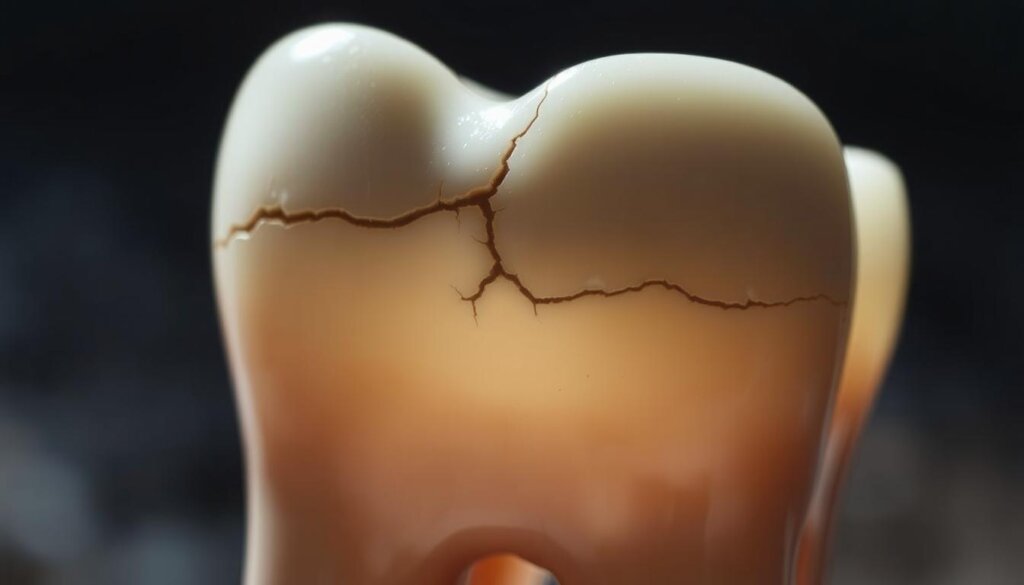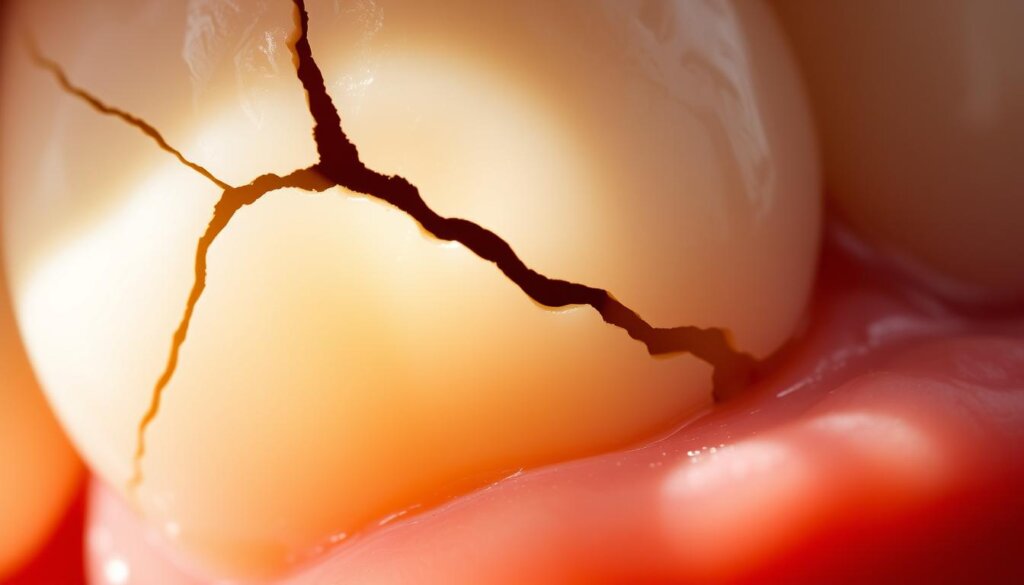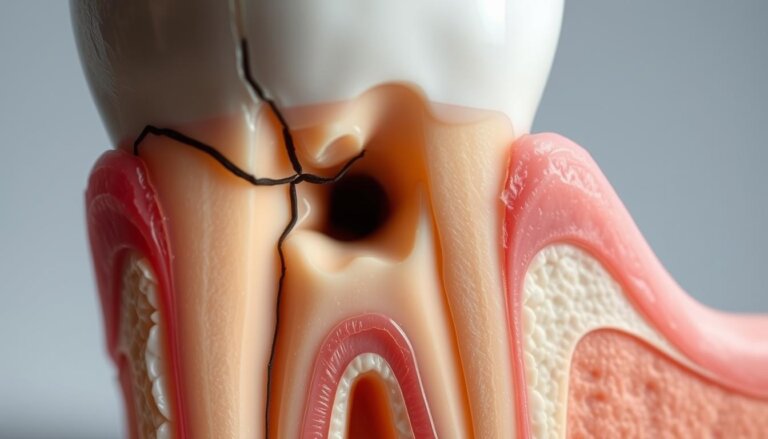Cracked Tooth Pain When Chewing: Causes & Relief
Many people wonder, Why does a cracked tooth sometimes hurt when chewing? Even a small crack can expose sensitive inner layers. This makes everyday meals feel uncomfortable.
Early care is key to avoid infections or tooth loss. This section will look at the main causes of pain from tooth cracks. We also talk about relief options. Our goal is to help readers get timely dental help and keep their teeth healthy for a long time.
Key Takeaways
- Cracked teeth commonly trigger unplanned dental appointments.
- Chewing intensifies discomfort by placing pressure on exposed nerves.
- Leaving a crack untreated may lead to infection or further damage.
- Prompt professional care can ease pain and preserve tooth structure.
- Regular check-ups support overall dental well-being.
Understanding Cracked Teeth
Teeth face a lot of pressure every day. This can weaken the enamel, leading to cracks. Even small cracks can grow and reach deeper layers.
What is a Cracked Tooth?
A cracked tooth is when the tooth structure breaks. This can happen in the enamel or dentin. Finding cracks early is key to avoiding bigger problems.
Common Types of Cracks
| Type | Key Features |
|---|---|
| Craze Lines | Thin, surface-level lines that rarely cause discomfort |
| Fractured Cusp | Small segment near the biting surface often breaking off |
| Central Crack | A split through the middle that may reach deeper tooth layers |
| Vertical Root Fracture | Extends from the root upward, creating a risk of infection |
Symptoms of a Cracked Tooth
- Intermittent discomfort that mimics typical cracked tooth pain
- Sensitivity to temperature changes or sweet foods
- Tenderness when biting into solid objects
These signs help doctors find cracks early. Taking action quickly can save the tooth and prevent pain. It also helps keep your mouth healthy for longer.
Why Do Cracked Teeth Hurt While Chewing?
Minor fractures can make tooth surfaces unstable. This can cause pain with every bite. Studies from the American Dental Association show that damage makes discomfort worse.
Pressure Sensitivity
Even small cracks in enamel can focus force on damaged areas. This causes sharp pains during chewing. These pains can happen when eating or doing daily tasks.
Nerve Irritation
Cracks can expose the inner pulp, making nerves more sensitive. Small changes in temperature or acidity can cause more pain. This can lead to a toothache from a cracked tooth, as the damage gets worse.
Impact of Food Choices
Some foods put extra pressure on cracked teeth. Hard candies and seeds apply direct force. Acidic drinks can also weaken enamel, causing more pain and inflammation.
| Trigger | Effect on Cracked Teeth |
|---|---|
| Hard Foods (nuts, ice) | Increases pressure, aggravates cracks |
| Cold Desserts | Sharp reactions in exposed nerves |
| Acidic Beverages | Weakens enamel, heightens irritation |
Causes of Tooth Cracking
Could biting on weakened enamel make chewing with a cracked tooth more painful? Many things can damage teeth. Cracks can make simple tasks hard. They come from daily wear or sudden impacts.
Aging and Wear
Enamel gets thinner with age, showing small cracks. These cracks grow with each bite. As we age, our teeth lose protection, making them more prone to pain.
Dental Treatments
Having many fillings or crowns can weaken teeth. This makes them more likely to crack. If too much stress builds up, a tooth can break without warning.
Trauma and Injury
Accidents or jaw injuries can cause tooth cracks. It’s important to see a dentist right away. Early treatment can help avoid more pain.
Signs You Might Have a Cracked Tooth
Cracks in the enamel can be hard to spot. They might cause minor changes in tooth color or make gums tender. These signs often mean you have a cracked tooth that needs attention.
Pain When Biting Down
When you bite down while eating, you might feel pain. This pain can get worse if the crack goes deeper. It’s a sign that your tooth needs to be checked.
Swelling and Sensitivity
Swollen gums can be a sign of irritation. This swelling might happen if you have a cracked tooth. Even small things like hot or cold can hurt if your tooth is damaged.
Discoloration of the Tooth
A change in tooth color can be a warning sign. Dark spots near cracks can mean bacteria or fluid are getting in. Catching this early can help avoid bigger problems.
How to Diagnose a Cracked Tooth
Spotting a cracked tooth requires a careful look at symptoms and how it feels under gentle pressure. Pain from a cracked tooth can get worse if not checked soon. It’s important to find out how deep the crack is early on.
Dental Examination Techniques
Dentists watch how you bite on a tool to find hidden pain spots. They use special lights to see small cracks. They might also use:
- Tooth Slooth testing
- Tactile probing
- Magnification lenses
These tools help find cracks that aren’t easy to see in a mirror.
X-Rays and Imaging
Digital X-rays show details that can’t be seen with the eyes. Cone-beam computed tomography gives a 3D view for better analysis. Getting X-rays early is key if you’re feeling pain when eating.
Seeking Professional Help
A dentist or endodontist checks the tooth’s crack to decide the best treatment. Their skills help avoid more damage and might save the tooth. This early action helps keep your smile healthy.
Treatment Options for Cracked Teeth
Cracked teeth often come from biting too hard. This shows the need for careful treatment. Doctors pick the best treatment based on how deep the crack is.
Once the tooth is fixed, it can handle biting better. This makes the tooth strong again.
Dental Bonding
Dental bonding fixes small cracks. A special resin fills the gap, making the tooth strong again. The dentist polishes it to look and feel natural.
Crowns and Caps
Bigger cracks need something stronger. Crowns cover the weak part of the tooth. They make the tooth strong and help it fit right in your mouth.
Root Canals
If the crack reaches the pulp, a root canal is needed. This removes the infected part, easing pain. After, the tooth is stable again.
This treatment stops the pain and prevents more problems.
Home Remedies for Temporary Relief
Acting fast can help ease tooth pain before you see a dentist. People with cracked teeth often try simple fixes to feel better. Using common items and over-the-counter products can help with swelling and pain.
Cold Compress
Putting an ice pack on your jaw can reduce swelling. Applying gentle pressure for a short time can help with pain without hurting more.
Over-the-Counter Pain Relievers
Medicines like ibuprofen or acetaminophen can help with pain. Just make sure to follow the instructions to avoid taking too much.
Saltwater Rinses
A warm saltwater solution can clean your mouth and reduce irritation. Swishing it around for a few seconds might help until you can get to a dentist.
| Remedy | Potential Benefits | Considerations |
|---|---|---|
| Cold Compress | Cools inflamed tissues | Use short sessions to avoid skin damage |
| OTC Pain Relievers | Decreases swelling and discomfort | Adhere to recommended dosages |
| Saltwater Rinse | Cleans surface bacteria | Not a permanent substitute for dental care |
Preventing Tooth Cracks
Can we protect our teeth before they get damaged? Yes, by taking consistent steps and making smart choices, we can keep our teeth strong. These actions help prevent cracks and give us peace of mind.
Good Oral Hygiene Practices
Brushing with fluoride toothpaste and flossing every day helps keep enamel strong. This makes our teeth less likely to crack. Regular cleanings also keep our teeth healthy and strong.
Avoiding Hard Foods
Staying away from hard foods like ice cubes or tough candy is key. These foods can damage our teeth. Eating softer foods helps keep our teeth safe and reduces the need for repairs.
Regular Dental Check-Ups
Going to the dentist regularly is important. It helps catch small cracks early. This way, we can fix them before they get worse. It also makes sure our teeth are aligned right.
| Prevention Method | Benefit |
|---|---|
| Consistent Brushing & Flossing | Maintains strong enamel |
| Choosing Softer Foods | Prevents sudden fractures |
| Routine Dental Visits | Enables prompt detection |
When to See a Dentist
Some cracked teeth don’t show symptoms. But, some signs mean you need to see a dentist. Ignoring these signs can lead to serious problems with your teeth.

Persistent Pain
If you feel pain when biting for days, your tooth might be damaged. Pain that gets worse with solid foods could mean something serious is wrong.
Symptoms of Infection
Swollen gums, warmth, or discharge could mean an infection. Fever is another sign your body is fighting an infection. You should see a dentist right away.
Prolonged Sensitivity
Feeling pain from hot or cold drinks that lasts more than a few seconds is a warning. It means the enamel is wearing down. Getting a dental exam and cleaning early can help avoid bigger issues.
| Symptom | Next Step |
|---|---|
| Lingering Jaw Ache | Request a timely checkup |
| Red or Swollen Gums | Discuss antibiotic therapy |
| Long-Lasting Sensitivity | Seek immediate attention |
The Role of Dental Insurance
Many people worry about the cost of fixing a cracked tooth. Dental insurance from providers like Delta Dental or Guardian can help. It covers diagnostic tests and treatments, but each plan is different. It’s important to check the details before getting care.
Understanding Coverage Options
Some insurance plans pay for imaging and special procedures. Others focus on basic care. The amount you get back can depend on your plan’s limits and copays. Reading your policy carefully can give you a clear idea of what’s covered.
Financing Treatments
Insurance isn’t always the best option. You can also pay for treatments in monthly installments. Talking to your dentist about payment plans can help you manage costs.
Preventive Care Benefits
Insurance often covers routine cleanings and checkups. These visits can catch problems early, saving you money. They also help keep your teeth healthy for longer.
Comparing Crowns and Fillings
Teeth with big damage need strong fixes. Crowns cover weak spots, keeping teeth working. Fillings fix small cracks in a gentle way.
When to Choose a Crown
For teeth with many cracks or under a lot of pressure, crowns are best. Dentists use special scans to check how strong the tooth is. This makes the tooth stronger and protects it from too much stress.
Benefits of Fillings
Fillings work well for small chips or tiny cracks. They’re a simpler fix that keeps the tooth’s natural look. The materials used can match the tooth’s color, keeping it looking natural.
Cost Considerations
Money matters when choosing dental fixes. Here are some points to think about:
- Crowns cost more upfront but last longer.
- Fillings are cheaper but might need to be done again.
| Feature | Crown | Filling |
|---|---|---|
| Longevity | 10+ years | 5–7 years |
| Coverage | Encases entire tooth | Targets limited area |
| Cost Range | Moderate to high | Lower initial expense |
The Importance of Oral Health
Oral health is key to feeling good overall. It affects digestion and how we see ourselves. Taking care of our teeth can lower inflammation and boost our health.
Connection Between Teeth and Overall Health
The American Dental Association found a link between bad teeth and heart disease and diabetes. Our teeth show us how our body is doing. So, it’s important to check them often.
Managing Stress to Prevent Grinding
Grinding can wear down our teeth. To stop it, we can try:
- Mindful breathing before bedtime
- Guided relaxation apps
- Physical exercise to release tension
Regular Check-Ups for Early Detection
Going to the dentist often can catch problems early. They can find small cracks and fix them. This keeps our teeth strong and our confidence up.
Myths About Tooth Cracks
Many people think a tooth crack is always visible. This belief can confuse those who feel pain during meals. What if tiny cracks are hidden under the enamel?
Common Misconceptions
Some think cracked tooth pain only hits older folks. But, bruxism and sports injuries can affect anyone. Another myth is that pain goes away once the tooth stops hurting. This makes some delay seeing a dentist.
Truth Behind Cracked Tooth Pain
Cracks can irritate the pulp, making every bite painful. Dentists use tools like transillumination to find hidden cracks. Quick action can stop more damage.
Understanding Risk Factors
Grinding teeth or using them as tools can cause cracks. Catching problems early and taking steps to prevent them can help. Those with cracked tooth pain often find relief with thorough exams and custom plans.
Lifestyle Changes for Better Oral Health
Keeping your teeth strong is more than just regular cleanings and check-ups. Your daily habits are key to preventing tooth cracks and keeping your smile bright.
Experts, like those at the American Dental Association, stress the need for balanced habits. These habits help keep your gums and enamel strong. Making small changes can lead to big health benefits.
Nutrition and Dental Health
Calcium and vitamin D are important for strong enamel. This protects your teeth from cracking. Eating foods like leafy greens, fortified cereals, and dairy products can help.
Some experts suggest eating:
- Lean proteins for tissue repair
- Crunchy vegetables for natural cleansing
- Low-sugar fruits to reduce acid production
Quitting Smoking
Smoking can harm your gums by reducing blood flow. This can lead to gum disease. Quitting smoking can improve your gums’ health and reduce inflammation.
Hydration and Its Benefits
Drinking enough water helps keep your saliva flowing. Saliva is your teeth’s natural protector. It helps prevent enamel erosion and tooth cracks.
| Nutrient | Benefit | Food Source |
|---|---|---|
| Calcium | Strengthens enamel | Milk, yogurt, kale |
| Vitamin D | Promotes mineral absorption | Salmon, egg yolks, fortified juice |
| Phosphorus | Rebuilds tooth structure | Beans, lentils, nuts |
Conclusion: Taking Action on Cracked Tooth Pain
Cracked tooth pain can get worse if not treated early. Quick action stops further damage and infection. Simple fixes like fillings and crowns can fix the problem and protect your tooth.
Importance of Timely Intervention
A damaged tooth can lead to bigger problems if not fixed fast. Quick treatment stops nerve damage and keeps your bite right. Fixing the tooth quickly keeps its shape and helps you heal faster.
Long-Term Dental Care Strategies
Good oral care stops cracks from coming back. Brushing and flossing every day helps. If the crack goes deep, a root canal might be needed. Your dentist will give you the best plan for your teeth.
Encouraging Regular Consultations
Regular dental visits catch new or bad cracks early. This limits big problems and lets for specific treatments. Healthy teeth last longer with visits every two years. Good habits and early advice keep your teeth healthy and pain-free.







